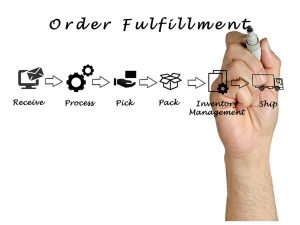September 29, 2016
In today’s competitive business landscape, higher SERP ranking has become one of the most important challenges to e-commerce sites. Let’s have a look at some reports of renowned online marketers. According to a data generated by Custora, 26% of ecommerce orders come from search engine traffic. Kissmetrics reports that 30.5% of all ecommerce traffic originates from search engines and according to NChannel, 44% of online customers start their shopping experience with search engines.
Therefore, it can be concluded that it’s hardly possible for e-commerce businesses to sustain without SEO. If you don’t have a solid grasp of SEO tricks and tips, you won’t be able to make it to the top, thus missing out on significant revenue. To many people, ecommerce SEO may seem quite simple but under the hood, there are lots of interrelated factors that have to be monitored and modified in a planned way to increase conversion rate. In this comprehensive guide for e-commerce sites, we’ve jotted down seven highly useful techniques that can be used to leverage SERP visibility.
Keyword Research
Keyword research is of immense importance when it comes to developing a successful ecommerce SEO campaign.

- Researching the big daddy first – Amazon: Let’s see how you can utilize the largest online ecommerce site Amazon for keyword research. First, type your product’s keyword in the Amazon’s search bar. Now, Amazon provides a list of long tail keywords that not only convert better but are less competitive too. Repeat the procedure to find keywords for your important products. These procedures are a result of researches conducted by Backlinko, which is a leader in building next-level SEO techniques. It’s common for a number of ecommerce site owners to optimize the category pages through random keywords. Though this process has some advantages, it’s not absolutely perfect. It’s important to note here that though category pages might not have benefits over product pages, they too generate some sales. Therefore, take your time to find unique category page keywords.
- Researching Google Keyword Planner: With Google Keyword Planner, you can make well-informed decisions about the keywords ideal for your business. This tool provides a comprehensive range of features to help you pinpoint a keyword’s popularity status, generate lots of keyword combinations in no time and remove low-volume searches. It isn’t a paid search tool and the data generated by it is immensely useful for ecommerce SEO. Keyword Planner enables you to research the following:
- Average monthly search amount for a certain period.
- Keyword ideas based on your landing page, product category or a specific phrase.
- Trends of search volume for keyword(s) over time.
- Average monthly search amount for a certain period.
- SEMRush: SEMRush helps you to identify the keywords that are doing well for your rivals. To complete your keyword research, you need to maximize its reach and to maximize the reach, you should incorporate a mix of keywords used by your competitors too (that suit your business well). SEMRush measures the SERPs for the rankings of keywords you’re looking for. Once you’ve identified your keyword ranking, review the sites with bigger keyword footprints. You should stay away from incorporating smaller brands because of their comparatively smaller presence in SERPs.
- Watch out for keyword cannibalization: Keyword cannibalization is a critical problem that occurs when the architecture information of a website heavily depends on a single key phrase or word. In some cases, it can happen unintentionally and due to a number of reasons like pagination. Though some webmasters intentionally optimize various pages with a single term to strengthen SERPs visibility, in reality, this effort leads to lower SEO effectiveness.
Making improvements to the website

It’s very important for you to improve your website as much as you can. An improved website not only helps in search engine crawling, indexing and its ranking but enhances visitor experience as well.
- Checking for existing site errors using Screaming Frog: Identification of existing site errors greatly helps ecommerce site owners to understand and rectify any poorly functional component or area of their websites, thus enhancing the sites’ online performance. With this check, you can have in-depth insights of your website and tweak the components obstructing your website’s present performance. Normally, a complete site audit seems to be an uphill and time-consuming task but tools like Screaming Frog has made the task easier for pros and newbies alike. Screaming Frog comes with an extremely user-friendly interface that helps you perform site audits easily to identify any existing errors.
- Changing the Title Tags and Meta Description of the products: Unquestionably, primary keyword of your product/service has to be there in the title tag of your page. But if you want your product/service to be present in long tail searches, add modifiers like ‘best’, ‘cheap’, ‘review’, ‘online’ etc. Rather than making a simple title tag, add words that people generally use when searching for similar products/services you offer. Meta description is the text that appears under the hyperlink of your page when it appears on SERP. Leverage this by inserting attractive text as meta description for your products.
- Optimizing the images and their tags: Just because the word out there in the market states that the crawlers from Google are not that adept at dealing with images and cannot understand the context they have been used in, people generally presume that this one concept of having the Alt tags for images can be overlooked. This is not so, and in disobeying this simple rule they might miss out on the little brownie points that Google might have vested upon them. Learning about the image optimization technique is a chance that you give your site to get friendlier with the search engine gods. Miss it and you miss your points as well.
- Getting the rich snippets right: Adding rich snippets is probably the easiest way to show up on Google’s first page. As an ecommerce site owner, you can leverage one of the most attractive rich snippets namely reviews. Implementation of Schema markup on the ecommerce product pages helps you to obtain eye-catching snippets. Schema markup is a kind of special code that needs to be added to specific pages on your website. This code provides the search engines with better understanding of the page’s content. Remember that it’s not guaranteed that search engines will exhibit the rich snippets but addition of appropriate Schema markup increases the chances.
- Internal linking: Google rates websites with valuable internal links favorably. The lesser clicks a visitor has to make to reach a desired page, the better. Therefore, it makes sense to link each page to other relevant pages in your site. Use of breadcrumbs not only improves a visitor’s journey across your site but also helps Google navigate throughout the site.
- Page loading speed: Once the errors have been taken care of, you should concentrate on improving the page loading speed. With a slow-loading website, it’s not possible to hold visitors for a long time. If your website takes more time to load than it should, you have to try to improve the site’s speed. Reduction of file and image sizes, use of a different CMS and buying more server space are some useful solutions.
Content for your products

Many ecommerce business owners underestimate the importance of valuable content for their products and the focus mainly encompasses the technical aspects of the site. But in reality, valuable content for products is equally significant to increase your conversion rate.
- Product description: You can simply copy and paste the product descriptions from the manufacturer’s website or can repeat existing content but this is neither desired nor effective. Rather, you should concentrate on writing unique product descriptions which will help you boost the conversion rate. While writing product descriptions and texts for images, include targeted keywords which will help to increase relevance scores of the pages.
- Consumer generated content:Encourage your customers to leave reviews for your products. That’s because more reviews are synonymous to more content and continuous reviews mean fresh content, which greatly would help in improving your site’s SEO. Besides, customer reviews act as original proofs to your prospective customers when it comes to becoming assured of the quality of their desired products. You may receive negative reviews which you may think as detrimental for your ecommerce business but in reality, these reviews help you improve your site and in turn, boost your future sales. You can feed customer reviews into the rich snippets and increase visitors’ movement across your site.
- Removing duplicate content: Many ecommerce business owners face issues with duplicate content when it comes to their websites’ mobile versions. Duplicate content not only cause SEO issues but also affects SERP ranking adversely. Use of responsive website design could give an ideal solution to this problem. A mobile responsive website seamlessly works on any device including desktop and mobile phones. Use of advanced SEO techniques such as canonical tags helps you weed out duplicate content issues. Canonical tags help search engines to understand that a certain page is an exact copy or a copy with little variations and thus, the page shouldn’t be treated as a unique one. Use duplicate content checkers to identify and take preventive measures to avoid having similar content from other websites.
Social media
Ecommerce SEO techniques always remain incomplete unless you make your product pages socially sharable.

Addition of social sharing buttons helps your products to increase their social exposure. You can also add custom sharing phrases like asking questions for the same purpose. Leverage social media to monitor your brand through Google Alerts is another useful strategy, which would let you obtain quality links related to your site. Remember to include targeted keywords in your Google Alerts to keep a track of your competitors’ activities.
Outreach and link building
To increase SERP visibility and awareness of your brand, you should use content outreach and link building. These help in identifying individuals, influencers and organizations related to your industry and connecting with them, thus building a healthy relationship.

- Product reviews: Connect with bloggers by following their blogs regularly and keep in touch with them through emails and social media platforms, share their posts, leave important comments to develop relationships. Request them to review your products and offer enticing incentives in return.
- Video reviews: Submission of video reviews of your products can help you increase SERP visibility of your product pages. Video sites like YouTube, Metacafe and Vimeo are considered to be good traffic sources when it comes to prospective customers looking for visually engaging reviews. This can also help in boosting organic and relevant traffic because of their high trustworthy nature.
- Competitor’s link: A successful ecommerce SEO campaign strategy should include analyzing the competitor’s link as it helps you to understand the keywords responsible for their higher ranking. Try to obtain links from authority domains or pages where your rivals are acquiring links from. Use tools like ‘Open Site Explorer’ to track the links of your competitors. Before engaging with the sites, remember to remove any site with low DA score from the list as this may affect your SEO performance.
Google product search optimization

Though your ecommerce site’s product pages can show up in standard web search, there is a more useful way to increase your SERP visibility. Google product feed is a data source of the meta data of your products that you submit to Google’s Merchant Center. Remember to submit adequate information about your products to the product feed to make them more useful and specific to user searches. Here’s how you can optimize the product search.
- Submit a comprehensive product listing with as many specific details as you can.
- You can manually submit individual products or else, if you want to submit the entire product database, do so using Google’s API.
- Include images in the listing.
- Ensure that your feed stays up-to-date.
- Consider Google Base to improve your search listings’ quality.
- Modify your content in accordance with seasons like holidays, winter etc.
- Use standard categories.
- Link your Google Merchant Center account to AdWords account and consider using Google’s Product Extension Ads to attain more control over your SERP visibility. In AdWords, you can include your product data feed to promote your products straight away in your ads. These will feature as product extensions.
What do I do with obsolete/expired products?

Every ecommerce site has some products that have expired permanently. It mainly happens in fashion clothing or consumer electronics when older products/styles are replaced with newer products/styles. Though you can simply remove that specific product page, it will affect your SEO performance. Here are some useful solutions that you can try in this regard.
- Redirect to the parent category: If you’ve relevant products that serve similar purpose like the expired product, you can redirect your visitors to your parent category.
- 301 Permanent redirect: If you’ve replaced the expired product by a newer one, use 301 permanent redirect that redirects the expired product’s URL to the newer product’s URL. It also helps Google understand that you want the newer URL to get ranked instead.
- Reuse URLs: If your ecommerce business consists of generic products, you can reuse the URLs to increase your SERP visibility and retain the page’s authority.
- Complete delete: In case you want to permanently delete an expired product’s page like deleting the URL, page and the content, use 410 status code that informs Google about the permanent removal of the page.
- Preserve informational pages: Certain informational product pages should be reserved to act as a valuable guideline for existing customers who may look for certain information, service and help through these pages.
Ecommerce businesses often face issues when dealing with ‘out of stock’ products. Here are three easy ways to resolve this.
- Clearly display ‘out of stock’ messages to let the users know the unavailability of the products.
- Display ‘shop more’ messages that encourage visitors to look around your website.
- Display ‘related products’ messages that help users find similar products.
Conclusion
Ecommerce site optimization is a bit different from the way general web marketers work to increase SERP visibility of various websites. For an ecommerce site, improving SERP visibility may be triggered by various reasons but the ultimate goal is to increase conversion rate. It’s important to note here that SEO for ecommerce sites isn’t a one-time occurrence; it’s an ongoing process instead. Major search engines keep modifying their algorithms to bring the best suited results to the searchers. So, you’ll also have to keep yourself updated about the modifications and change your strategy accordingly to reap the benefits of higher SERP visibility. Though various other strategies are there to leverage SERP visibility, the above mentioned ones are proven and the most-used when it comes to improving your ecommerce site’s performance.
Digital & Social Articles on Business 2 Community(93)







